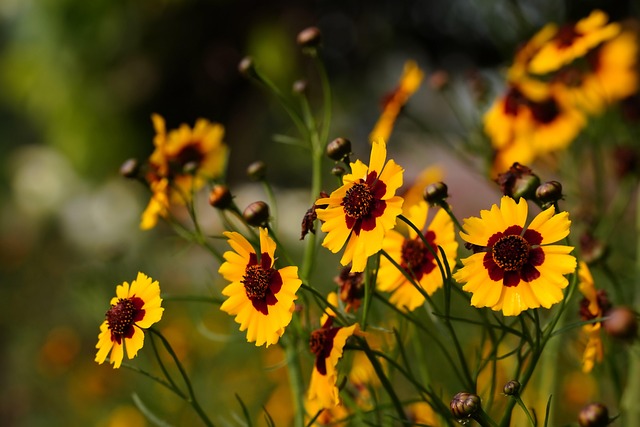A low-maintenance garden is achieved through strategic choices like selecting drought-tolerant perennial flowers, incorporating native plant landscaping, and using mulching and efficient irrigation systems. Alternatives to traditional lawns, such as rock gardens or gravel paths, further reduce maintenance. These methods conserve water, control weeds, and provide year-round aesthetic appeal with minimal upkeep.
Create a stunning yet low-maintenance garden with strategic design choices that cater to today’s busy lifestyles and environmental concerns. This guide explores effective solutions for cultivating a vibrant space with minimal effort. Discover the power of drought-tolerant plants, explore enchanting perennial flowers for easy care, and learn mulching techniques to control weeds while retaining moisture. Additionally, we delve into smart irrigation systems and alternative lawn solutions, offering practical tips on native plant landscaping and hardscaping ideas for a water-wise oasis.
- Choosing Drought-Tolerant Plants for a Water-Wise Garden
- Perennial Flowers: Low-Maintenance and Stunning Options
- Mulching Techniques to Control Weeds and Retain Moisture
- Smart Irrigation Systems and Alternative Lawn Solutions
Choosing Drought-Tolerant Plants for a Water-Wise Garden

Creating a low-maintenance garden means selecting plants that are designed to thrive with minimal care. One of the most effective ways to achieve this is by choosing drought-tolerant plants, perfect for water-wise gardening. Perennial flowers top the list for their ability to return year after year, requiring less replanting and ensuring consistent beauty. These plants also establish deep root systems that help to conserve moisture, making them ideal for regions with limited rainfall.
Incorporating native plant landscaping is another smart design choice. Native species are adapted to local conditions, including typical weather patterns and soil types, which means they require less watering and maintenance compared to non-native varieties. Additionally, mulching around these plants can further reduce weed growth and moisture loss from evaporation, making it an essential low-maintenance garden tip. Consider automatic irrigation systems for more advanced solutions, ensuring your plants get the water they need without constant supervision. For those looking to replace traditional lawns, low-maintenance lawn alternatives like native grasses or rock gardens offer beautiful hardscaping ideas that are both visually appealing and easy to maintain.
Perennial Flowers: Low-Maintenance and Stunning Options

Perennial flowers are a cornerstone of any low-maintenance garden, offering stunning visuals with minimal upkeep. These plants return year after year, reducing the need for annual planting and fostering a more sustainable garden ecosystem. When selecting perennials, choose drought-tolerant varieties that thrive in your region’s climate to cut down on watering requirements. Options like lavender, sedum, and daylilies not only withstand periods of dryness but also attract beneficial insects, contributing to a healthier garden.
Implementing effective weed control measures is another vital low-maintenance garden tip. Mulching around perennial flowers can significantly reduce weed growth by blocking sunlight and moisture from reaching unwanted plants. Consider using organic mulches like wood chips or straw, which enhance soil fertility as they decompose. Additionally, automatic irrigation systems with smart sensors ensure your perennials receive just the right amount of water, preventing overwatering and promoting healthy root growth. For those looking to replace traditional lawns, low-maintenance lawn alternatives such as gravel paths, paved patios, or native plant landscaping offer appealing hardscaping ideas that require little to no mowing or watering.
Mulching Techniques to Control Weeds and Retain Moisture

Creating a low-maintenance garden starts with strategic mulching techniques. By applying a layer of organic mulch around plants and shrubs, you can effectively control weeds and reduce water evaporation from soil. This simple step is crucial for retaining moisture in drought-tolerant plants, saving time on weeding and watering. Perennial flowers are an excellent choice for easy care; they return year after year with minimal effort.
Consider native plant landscaping, which not only requires less maintenance but also supports local ecosystems. Automate irrigation systems to ensure your garden gets the right amount of water without constant oversight. For those looking to ditch the lawn altogether, explore low-maintenance lawn alternatives like hardscaping ideas using gravel or decorative stones. These options reduce watering needs and eliminate the hassle of mowing.
Smart Irrigation Systems and Alternative Lawn Solutions

Creating a low-maintenance garden doesn’t mean sacrificing beauty or vibrancy; it’s all about making smart design choices. One such choice is adopting smart irrigation systems that utilize technologies like drip irrigation and weather-based controllers to deliver water precisely where needed, minimizing waste and ensuring plants receive just the right amount. This method, combined with drought-tolerant plants and mulching for weed control, can significantly reduce watering needs.
Alternative lawn solutions, such as native plant landscaping, offer both visual appeal and practical benefits. Native perennials require less care than traditional grass and provide habitat for local wildlife. Hardscaping ideas, like pathways made from gravel or stone, reduce the need for frequent mowing and weeding. By integrating these low-maintenance lawn alternatives and drought-tolerant plants into your garden design, you can create a lush, vibrant space that demands less upkeep but offers year-round beauty.
Creating a low-maintenance garden doesn’t mean sacrificing beauty or diversity. By strategically incorporating drought-tolerant plants, efficient mulching techniques, and smart irrigation systems, you can achieve a stunning outdoor space that requires minimal upkeep. Native plant landscaping offers both aesthetic appeal and ecological benefits, while hardscaping ideas provide functional solutions for busy gardeners. With these simple yet effective tips, transform your garden into a thriving oasis that complements your lifestyle without compromising on visual allure.
